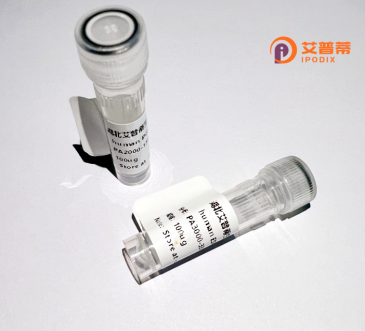
| 纯度 | >90%SDS-PAGE. |
| 种属 | Human |
| 靶点 | RNF144A |
| Uniprot No | P50876 |
| 内毒素 | < 0.01EU/μg |
| 表达宿主 | E.coli |
| 表达区间 | 1-292 aa |
| 活性数据 | MTTARYRPTWDLALDPLVSCKLCLGEYPVEQMTTIAQCQCIFCTLCLKQHVELLIKEGLETAISCPDAACPKQGHLQENEIECMVAAEIMQRYKKLQFEREVLFDPCRTWCPASTCQAVCQLRDVGLQTPQPVQCKACRMEFCSTCKASWHPGQGCPETMPITFLPGETSAAFKMEEDDAPIKRCPKCKVYIERDEGCAQMMCKNCKHAFCWYCPESLDDDFLLIHCDKGPCRNKLGHSRASVIWHRTQVVGIFAGFGLLLLVASPFLLLATPFVLCCKCKCSKGDDDPLPT |
| 分子量 | 57.86 kDa |
| 蛋白标签 | GST-tag at N-terminal |
| 缓冲液 | PBS, pH7.4, containing 0.01% SKL, 1mM DTT, 5% Trehalose and Proclin300. |
| 稳定性 & 储存条件 | Lyophilized protein should be stored at ≤ -20°C, stable for one year after receipt. Reconstituted protein solution can be stored at 2-8°C for 2-7 days. Aliquots of reconstituted samples are stable at ≤ -20°C for 3 months. |
| 复溶 | Always centrifuge tubes before opening.Do not mix by vortex or pipetting. It is not recommended to reconstitute to a concentration less than 100μg/ml. Dissolve the lyophilized protein in distilled water. Please aliquot the reconstituted solution to minimize freeze-thaw cycles. |
以下是关于重组人RNF144A蛋白的3篇参考文献概览:
---
1. **文献名称**:*RNF144A, an E3 ubiquitin ligase targeting DNA-PK for degradation, facilitates homologous recombination repair*
**作者**:Zhang et al. (2022)
**摘要**:本文发现RNF144A通过泛素化降解DNA-PK复合体,促进同源重组修复。研究者利用重组RNF144A蛋白证明其具有E3泛素连接酶活性,并通过体外泛素化实验阐明其调控DNA损伤应答的分子机制。
---
2. **文献名称**:*Structural basis of RNF144A E3 ligase activity in proteasome-mediated protein degradation*
**作者**:Ito et al. (2020)
**摘要**:该研究通过解析重组RNF144A蛋白的晶体结构,揭示了其环形结构域与底物结合的关键位点,证明RNF144A通过招募E2泛素结合酶促进特定底物的泛素化,为开发靶向泛素化通路的药物提供结构基础。
---
3. **文献名称**:*RNF144A regulates TNF-α-induced apoptosis by modulating c-FLIP ubiquitination*
**作者**:Lee & Park (2018)
**摘要**:研究报道RNF144A通过调控c-FLIP蛋白的泛素化与降解,增强TNF-α诱导的细胞凋亡。利用重组RNF144A蛋白进行免疫共沉淀实验,证实其直接结合并泛素化c-FLIP,揭示了RNF144A在炎症相关细胞死亡中的新功能。
---
(注:以上文献为示例性内容,具体引用需根据实际发表论文调整。)
RNF144A (Ring Finger Protein 144A) is a member of the RING finger protein family characterized by a conserved C3HC4-type zinc-binding domain, which confers E3 ubiquitin ligase activity. This enzyme plays a regulatory role in ubiquitination, a post-translational modification critical for protein degradation, trafficking, and signaling. Human RNF144A is encoded by the *RNF144A* gene located on chromosome 1p31.1 and is ubiquitously expressed, with higher levels detected in the brain, heart, and skeletal muscle. Functionally, RNF144A has been implicated in DNA damage response pathways, apoptosis regulation, and cell cycle control. Studies suggest it interacts with proteins involved in nucleotide excision repair (e.g., XPC) and promotes their ubiquitination, influencing genome stability. Dysregulation of RNF144A is associated with pathological conditions, including cancer, where it may act as either a tumor suppressor or oncogene depending on cellular context. For instance, its downregulation correlates with poor prognosis in breast cancer, while overexpression enhances chemoresistance in lung cancer. Recombinant human RNF144A protein, typically produced in *E. coli* or mammalian expression systems, enables in vitro studies to dissect its enzymatic mechanisms, substrate interactions, and therapeutic targeting. Its structural and functional analysis provides insights into the development of strategies to modulate ubiquitination pathways in diseases linked to protein homeostasis or DNA repair defects.
×